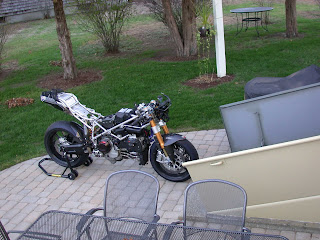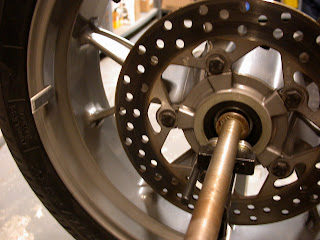
I must admit that I'm a bit of a "dumpster diver"- have been from way-back, runs in the family! Plus, I'm cheap (to a degree).....so having no shame about routing around through the thrash helps. I must also say that I tend to use everything I bring home, it may be years before I need it but I always seem to make use of the item or piece of "scrap".
Take the nice piece of perforated stainless steel sheets that were used in my "free" parts washer. After a couple of cuts, folds, and rivets attaching it to a discarded bin zip-tied to procured milk crates (yeah, I know about the legal warnings on the things....but what can I say, I guess I live dangerously!) I had a nice unit.

Using a combination of parts washing fluid (pressurized bottle), and spray cans of Brakleen (high solvent and low solvent) I can clean my parts and the excess fluid drains into the bin where most of it evaporates. I've got a brush and blow gun there also.

I designed it to be at working level right outside the workspace, behind the doors separating the heated shop from the stairs and bulkhead. Notice the white box to the lower right- this is the fan setup that I use when I paint in the room, I've just turned the opening 90 degrees (from the covered opening to the shop-red door) to suck out the fumes when I turn on the fan--it works great--no more filling the house with strong brake cleaner fumes. When I'm done washing parts I just shut the door, let the fan run for awhile to evacuate the remaining nastiness and that's it.
It's out of the way, accessible, easy to use.......and, best of all FREE!!
 I decided to clean up and drill a few more holes for the safety wire clips in the front caliper mounting bolts. The bolt laying on the vise to the right is the slightly corroded bolt and the left one has been polished.
I decided to clean up and drill a few more holes for the safety wire clips in the front caliper mounting bolts. The bolt laying on the vise to the right is the slightly corroded bolt and the left one has been polished. This cut off wheel for the Dremel tool shows the quick release style hole for the new style arbor. I found this setup makes changing out the wheels a heck of a lot quicker.
This cut off wheel for the Dremel tool shows the quick release style hole for the new style arbor. I found this setup makes changing out the wheels a heck of a lot quicker. Once I polished the heads of the bolts I hit them with a little clear laquer in an effort to keep them from corroding again.
Once I polished the heads of the bolts I hit them with a little clear laquer in an effort to keep them from corroding again. If you're going to attempt bolt drilling for safety wire, stock up on 1/16" hardened drill bits.
If you're going to attempt bolt drilling for safety wire, stock up on 1/16" hardened drill bits. I drilled the heads out on every flat of the socket head making it easier to position the clips where they would line up properly. That neat Park Tool makes it easy to hold different diameter bolts in the vise. Handy.
I drilled the heads out on every flat of the socket head making it easier to position the clips where they would line up properly. That neat Park Tool makes it easy to hold different diameter bolts in the vise. Handy. A small adjustable angled vise makes it easy to hold bolts firmly on the drill press. Don't forget the oil for cooling the drill bit.
A small adjustable angled vise makes it easy to hold bolts firmly on the drill press. Don't forget the oil for cooling the drill bit. Gotta have a drill press.
Gotta have a drill press. The Dremel (Sears actually) tool with the polishing quick-release wheel.
The Dremel (Sears actually) tool with the polishing quick-release wheel.


































 Here's the naked wheel on the balancer to find the true heaviest spot.
Here's the naked wheel on the balancer to find the true heaviest spot.








